The surface of the earth is uneven, some parts may be rugged and some flat. The earth has an immeasurable variety of landforms.
These landforms of the earth are the result of two processes and they are:
- Internal process- The Internal Process leads to the upliftment and sinking of the earth’s surface.
- External process- It is the continuous wearing down and rebuilding of the land surface and includes two processes namely:
- Erosion– It is the wearing away of the earth’s surface.
- Deposition– It is the rebuilding of a lowered surface (occurred due to erosion).
The erosion and deposition processes are carried out by running water, ice, and wind.
Landforms can be grouped based on the elevation and slope and they are:
- Mountains
- Plateaus
- Plains
In this article, you will read these five major landforms of the Earth:-
- Fluvial landforms or landforms made by the water channel
- Aeolian Landforms or Landforms made by winds
- Glacial landforms
- Wave landforms
- Karst Landforms
Some Important points
- Folding, Faulting, and Vulcanism are three prominent processes that form secondary landforms on earth due to endogenic forces.
- Folding occurs in case of compression force while faulting occurs in case of Tension as well as Compression
- Faults formed due to tension are called normal faults and leads to the formation of a new surface while faults formed due to compression forces are called reverse faults which lead to the destruction of the surface.
- Folding is seen rarely seen in metamorphic rocks (Note: it’s rare and not absent) because they are hard and brittle, instead of folding they break and form reverse fault.
- Volcanoes are found at plate boundaries as well as inside the continent. At the plate boundaries, volcanoes are associated with Continental – oceanic and Oceanic – oceanic convergence. In this case, they form cone volcanoes. They are also found at oceanic – oceanic divergence where Mi-oceanic ridge is formed.
- Inside the continent, volcanoes are found due to hot spot activity. A mental plume breaks the lithosphere from where it is thin and oozes out to form a shield.
Fluvial landforms or landforms made by the water channel
Erosive landforms
V shape valley – In the youth stage, the flow of water in the stream is too fast. Because of this vertical erosion at the center is much faster than lateral erosion. This causes river streams to carve a V shape valley in the mountains.
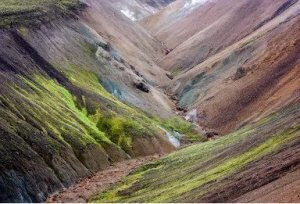
Pot holes – Pot holes are formed in river valleys due to abrasion caused by a big boulder on the surface of the channel. Because of the flow of water, it rotates at its place. As friction is acting between the surface and the rock, the rock gets reduced in size and also depression is formed on the surface. This depression is called a pot hole. Once the bolder gets small enough for the stream to carry it, it pushes it downstream.
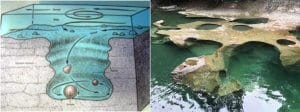
Waterfalls and plunge pools – Waterfalls are formed when water directly falls from a steep slope. As it hits the valley, because of impact, a plunge pool is formed.
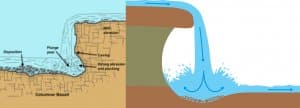
Cascades – You all must have seen stepped waterfalls that don’t fall from a great height but falls stepwise. They are called cascades.
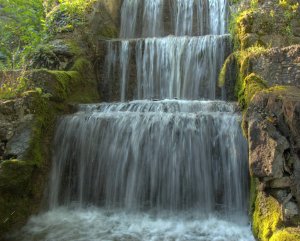
Rapids – If you have done white water rafting, you must know what a rapid is. for a short distance, there is a sudden increase in the slope of stream. Note that this increase is not enough to cause a free fall, but steep enough to suddenly increase the flow of water. This is called rapid.
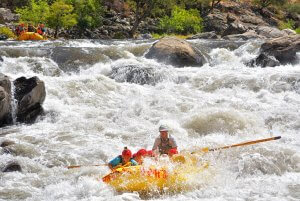
River water capturing – This happens when the origin of a lower stream shifts upward due to headward erosion and touches the side of a stream flowing in a higher valley. As the water flowing in the higher valley gets another valley to flow with a steeper slope, it shifts its path and starts flowing in the new valley. This phenomenon is called River water capturing.
The preconditions for river water capturing to occur are –
- There should be a difference in height of the two streams.
- The lower stream should be on the windward side so that it can receive ample rainfall for headward erosion.
- The slope of the lower stream should be steeper.
It is believed that the Yamuna river captured the water of Saraswati. Saraswati in modern times is left as a seasonal stream called Ghaggar which flows from Haryana to Rajasthan.
Meanders – Meanders is the name given to snake-like zig-zag shape made by river channel in a plain area. This occurs due to erosion on one bank and deposition on another. On the convex side, the water flow is faster causing erosion, this side is called the cliff bank. On the concave side as the flow of water is slow, sand deposition is there. This is called the point bar.
Depositional Landforms
Oxbow lake – it is formed due to the deposition of sand on the concave side of the meander. The steepness of the curve increases and meander gets detached from the river channel. The stagnant water of the meander forms an oxbow lake.
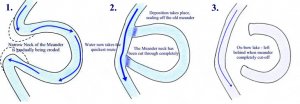
Flood plain – Flood plain is the area on both sides of the riverbank to the extent where floodwater reaches. Flood water renews the deposits in the flood plains and replenishes the nutrients making them fertile. As long as the water remains on the flood plain, it is called ‘Bet’ land.
Karewas – Karewas are lacustrine deposits (deposits in a lake) in the Valley of Kashmir and in Bhadarwah Valley of the Jammu Division. It is an intermountain valley fill, comprising of unconsolidated gravel and mud. A succession of plateaus is present above the Plains of Jhelum and its tributaries. These plateau-like terraces are called ‘Karewas’ or ‘Vudr’ in the local language.
Braided channel and Riverine island – Riverine islands are formed in the old stage of the river when sediments get deposited in the river channel itself. These deposits of sand divide the channel into multiple parallel streams looking like a hair braid. This channel is called the braided channel.
Natural Levees – This is the uplifted part on both sides of the bank. This is formed due to the deposition of sand on the edges. It creates a natural barrier between the river channel and the floodplain.
Delta – Delta is the final depositional formation of a river before it meets the ocean. The deposits carried by the river are deposited at the mouth of a river forming a large alluvial fan. It is called a delta. On the basis of shape deltas are of three types –
- Arcuate Delta – this is the most common type of delta and is formed when the deposits of the river have a higher density than ocean water. This makes deposits heavier and they get deposited at the mouth forming an outward arc. The best examples of such deltas are Sunderbans and Nile delta.
- Cuspate delta – it is formed along the edge of the bank at the mouth of a river. It is formed when the density of sediments is equal to that of ocean water. The best example of this delta is made by River Tiber (Italy).
- Bird Foot delta – It is a branched delta and is formed when the density of deposits is less than the density of ocean water. The particles are carried away inside the ocean to a long distance before they settle down. The best specimen of birdsfoot delta is made by the Mississippi River.
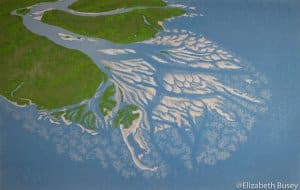
- Interlocking spurs
- Ox-bow lakes
- River cliffs
- Rapids and waterfalls
Which of the above will be found in the middle course of the river system?
a) 1, 2
b) 2, 3
c) 3, 4
d) 1, 3
Solution: d)
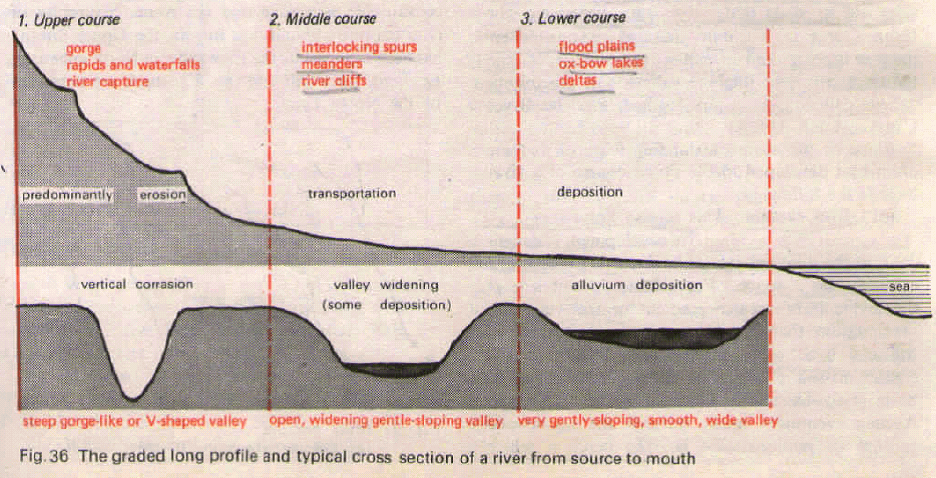
a) Came from a nearby water source.
b) Was deposited at the location where it was found.
c) Traveled from a distant source area.
d) Have not been influenced by weathering
Solution: c)
Sediment Maturity refers to the length of time that the sediment has been in the sedimentary cycle. Texturally mature sediment is sediment that is well rounded, (as rounding increases with transport distance and time) and well sorted (as sorting gets better as larger clasts are left behind and smaller clasts are carried away. Because the weathering processes continues during sediment transport, mineral grains that are unstable near the surface become less common as the distance of transport or time in the cycle increases. Thus compositionally mature sediment is composed of only the most stable minerals.
- Rise in sea level
- Submergence of a part of a continent
- Sedimentary deposits brought down by rivers
Which of the above statements is/are correct?
a) 1, 2
b) 2, 3
c) 1, 3
d) 1, 2, 3
Solution: d)
Continental Shelf is the submerged edge of a continent which is a gently sloping plain that extends into the Ocean. The typical gradient is less than 1°. The average width of continental shelves is about 80 km. The largest continental shelf is the Siberian Shelf in the Arctic Ocean, which stretches to 1,500 kilometers in width. Because of the gentle slope, the continental shelf is influenced by the changes in the sea level.
The shelf is formed mainly due to
- Rise in sea level
- Submergence of a part of a continent
- Sedimentary deposits brought down by rivers
Aeolian Landforms or Landforms made by winds
Erosional Landforms
Blowout – Wind blows the topsoil in desert areas and forms a depression.
Mushroom rock – probably the most famous erosional Aeolian landform. The wind erodes a large rock from the bottom and carves a mushroom-like shape in it.
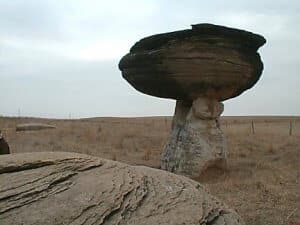
Yardang – When the wind is blowing on one side of the rock it gets eroded from one side and carves a table-like structure.
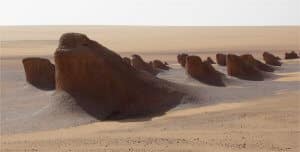
Dreikanter – It is formed the same way mushroom rocks are formed but it looks like an inverted cone attached to the ground with a very small neck.
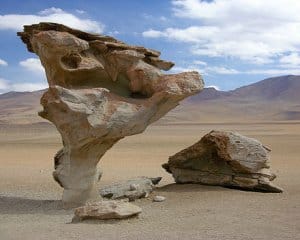
Demoiselles – They are pillars formed due to differential erosion. If resistive rocks are on the surface, erosion occurs on the sides rather than the top and the lower soft rocks are eroded.
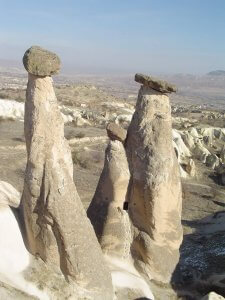
Zeugen – It is a beautiful ridge carved by the action of wind, moisture, and frost.
Depositional Landforms
Sand dunes – They are found in the sandy desert. Sand dunes are mounds of sand formed as wind
deposits sand brought from rocky deserts.
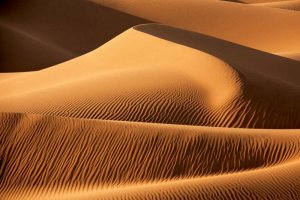
Largest of the Sand dunes are called Barchans. They are formed in the direction of the flow of the wind. Largest Barchans are found in the desert of Saudi Arabia.
Seifs – Seifs are also sand dunes but much smaller in size. They are found in regions where sand is less and they are found in a group i.e. multiple seifs are found together.
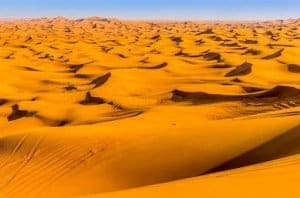
Nephkha – they are sandy deserts by the side of a mountain range. The mountain range breaks the momentum of air and a decrease in speed allows the particles to settle down.
Loess – Loess is fine deposits taken to thousands of kilometers from their region of origin. Fine loess of Plain of Normandy is formed by particle deposited from Sahara. Another example of loess is Manchuria plain which gets its sediments from Mongolia.
Glacial landforms
Erosional
Arete – It is also known as biscuit tray topography. If you have been to the Himalayas, you must have seen that mountains are pyramidal in shape with sharp-edged. These sharp edges are called Arete.
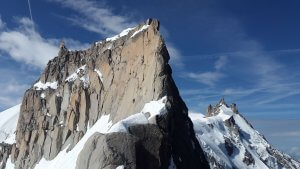
Cirque – Between the edges, the face of the mountain looks like someone has scooped the material out of it. This depression is called a cirque.
Horn – The sharp spear looking top of a mountain is called Horn.
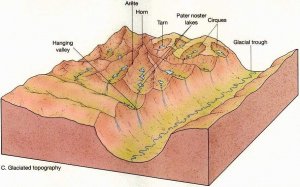
U–Shape Valley – the Formation of a U – Shape valley is similar to that of a V – Shape valley. But unlike V shape valley where the flow of water is significantly faster in the center, in case of a glacier, the speed of snow is relatively a bit faster than the outer snow. Also, the mass of Snow is high. Because of this a U shape valley is formed.
Hanging Valley – When a glacier fills a former river valley it is at a much higher level and therefore any tributary glaciers will join the main glacier also at a higher level. Once the glacier has eroded it leaves the tributary valley hanging at the side of the main valley. If a stream enters the hanging valley it plunges over the edge like a waterfall.
D–Fjord – steep-sided narrow entrance-like feature at the coast where the stream meets the coast. Fjords are common in Norway, Greenland and New Zealand.
Depositional Landforms
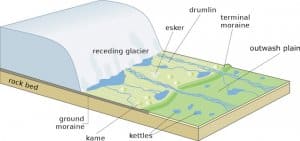
Outwash Plain – It is formed by the melting of the glacier. A water stream is formed leaving debris behind.
Eskers – A long narrow ridge, often sinuous, composed of stratified sediment and marking the
former location of a glacial tunnel.
Drumlin – It is a collection of Round boulders in the outwash plain. A collection of such boulders looks like an inverted basket. This is also called Egg basket topography.
Kettle Holes – They are formed by plucking of boulders and rocks from the outwash plain and creating a depression.
Kame – they are broken ridges or unassorted depositions forming a mound.
Morain – They are the most famous deposits.
Pieces of gravel and boulders get accumulated along the edge of the glacier as well as the mouth. These deposits are called Lateral moraine and terminal moraine respectively.
| Glacial Erosional Landforms | Glacial Depositional Landforms |
| The major erosional landforms made by glaciers are: Cirque Horns and Serrated Ridges Glacial Valleys/Troughs | The major depositional landforms made by glaciers are: Esker Outwash plains Drumlins |
| Alpine Glaciers | Ice Sheets |
| Alpine glaciers are formed on the mountainsides and they usually move downwards through the valleys. There are times when an alpine glacier also deepens the valleys by pushing away the dirt, soil, and other materials. These glaciers are found in high mountains. | Ice sheets form broad domes and usually spread out in all directions. When the ice sheets spread, they cover all the areas such as valleys, plains, and mountains with a thick blanket of ice. The continental glaciers are the largest ice sheets and cover most of Antarctica and the islands of Greenland. |
Gangotri Glacier
This is an important glacier in India.
- Largest Glacier in Uttarakhand.
- Source of the Ganges. (River Bhagirathi)
- The Gangotri glacier originates at the northern slope of Chaukhamba range of peaks in Garhwal Himalayas.
- Gangotri is not a single valley glacier, but a combination of several other glaciers.
Carbon Deposits on Gangotri
- The Wadia Institute of Himalayan Geology is an Autonomous Institute administered by the Department of Science and Technology.
- They have the Chirbasa station at a height of 3,600 m and Bhojbasa station at a height of 3,800 m.
- They research the number of carbon deposits on the important glaciers of the Himalayas. Gangotri being the source of the Ganges is one of the most important Glaciers in the country.
- According to recent data from the research, the concentration of Black Carbon present on the Gangotri Glacier has doubled when compared to the results of the past few years.
- The primary reason for this is the agricultural burning and forest fires in the nearby regions.
Glacial Lake Outburst Floods –
A glacial lake outburst flood (GLOF) is a type of outburst flood that occurs when the dam containing a glacial lake fails. The dam can consist of glacier ice or a terminal moraine.
GLOFs have three main features:
- They involve sudden (and sometimes cyclic) releases of water.
- They tend to be rapid events, lasting hours to days.
- They result in large downstream river discharges (which often increase by an order of magnitude).
Failure can happen due to erosion, a buildup of water pressure, an avalanche of rock or heavy snow, an earthquake, or massive displacement of water in a glacial lake when a large portion of an adjacent glacier collapses into it.
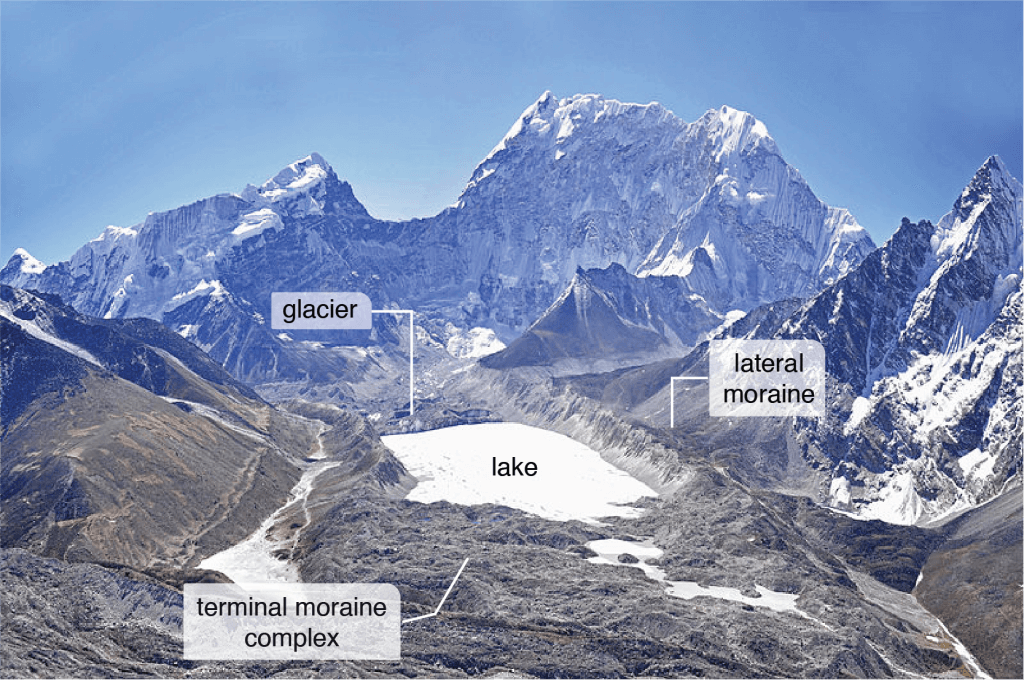
Wave landforms
Erosion landforms
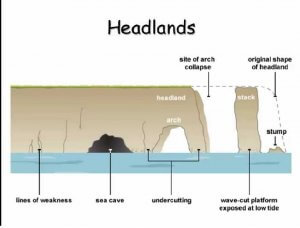
Note: Erosional landforms from waves are carved on the cliff side which has resistant rocks.
Notch – A notch is formed by the direct impact of the primary waves. Primary waves are those which move perpendicular to the coast. Due to impact and abrasion, a cavity is formed on the wall which is called a notch.
Note: Primary waves are responsible for erosional landforms and secondary waves are responsible for deposition.
Cave – It is formed when a notch enlarges to form a cave.
Stack – As the erosion continues the roof of the cave becomes thinner and finally falls down. The walls of the cave remain intact forming Pillars. They are called stacks. Finally, these stacks wither away leaving stumps.
Cove – A cove is a small type of bay or coastal inlet. Coves usually have narrow, restricted entrances, are often circular or oval, and are often situated within a larger bay.
Remember, there is a difference between the cove and a cave.
Depositional Landforms
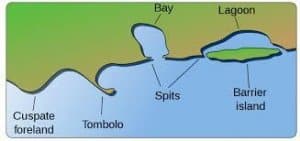
Beach – Beach is the most famous depositional landform of waves. Depending on the size of sediments, beaches can be Boulder beach, shingle beach or sand beach.
Sand bar – It is the deposition of sand extending into the sea. On the basis of formation, it can be parallel sand bar or perpendicular sand bar. If a perpendicular sand bar is attached to the continent from one end, it is called a Spit.
Hook – If an ocean current is moving along the coast where spit has formed, the spit gets curved in the direction of the current. This curved spit is called a hook. Sometimes, there are several branches coming out of spit curving in the same direction. It is called a compound hook.
Loop – When hook gets too curved, it touches the coast from the other end and forms a complete loop forming a lake. The lake is called lagoon and the sandbar enclosing is called a loop.
Tombolo – If a sand bar connects a continent with an island forming a natural bridge, it is called a Tombolo.
Karst Landforms
Karst is a topography formed from the dissolution of soluble rocks such as limestone, dolomite, and gypsum. It is characterized by underground drainage systems with sinkholes and caves. It has also been documented for more weathering-resistant rocks, such as quartzite, given the right conditions. Subterranean drainage may limit surface water, with few to no rivers or lakes.
However, in regions where the dissolved bedrock is covered (perhaps by debris) or confined by one or more superimposed non-soluble rock strata, distinctive karst features may occur only at subsurface levels and be totally missing above ground.
Preconditions for the formation of Karst Landform-
- Rainfall should be optimum (Semi-arid region). Rainfall should be moderate i.e. it shouldn’t be high otherwise it will dissolve the entire rock structure without forming desired topography. It should be too low either otherwise, water won’t be able to dissolve the rock at all.
- The thickness and area of the limestone rock bed should be large enough for carving.
- The rock should be jointed and the density of joints should be high so that water can penetrate through cracks systematically eroding the rock bed.
- Rocks should not be porous otherwise water will penetrate through the body of the rock and dissolve the whole rock rather than surface erosion.
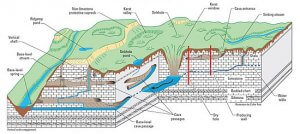
Surface Landforms
Different depressions are formed on the surface by seeping of water –
Sinkhole – It is a small deep depression formed on the surface. A sinkhole is a depression in the ground that has no natural external surface drainage. Basically this means that when it rains, all of the water stays inside the sinkhole and typically drains into the subsurface. Sinkholes are most common in Karst Terrain.
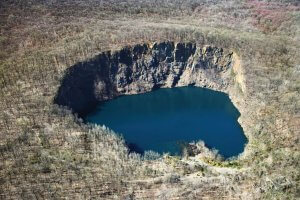
Sinking Creeks/Bogas– In a valley, the water often gets lost through cracks and fissures in the bed. These are called sinking creeks, and if their tops are open, they are called bogas.
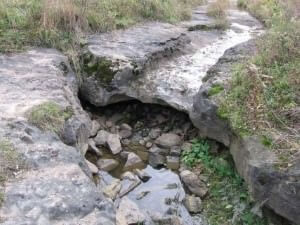
Doline – Few sinkholes combine to form a larger depression called Doline. Sometimes clay gets settled on the bottom of Doline stopping water to seep through it. When water gets accumulated in the doline, it is known as a Doline Lake.
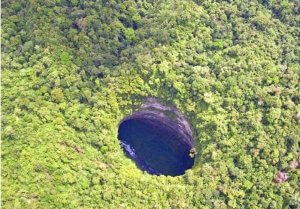
Uvala – several Dolines combine to form an Uvala.
Polje – When an underground cave collapsed, over the surface a large depression is formed. It is called Polje.
Subsurface Landforms
Stalactites and Stalagmites – Stalactite and stalagmite, elongated forms of various minerals deposited from solution by slowly dripping water. A stalactite hangs like an icicle from the ceiling or sides of a cavern. A stalagmite appears like an inverted stalactite, rising from the floor of a cavern.
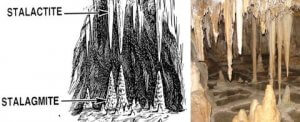
Column – When stalactite and stalagmite meet, they form a complete pillar in the underground cave. This is called a column.
Cavern- This is an underground cave formed by water action by various methods in a limestone or chalk area.
Karst Window – When a number of adjoining sinkholes collapse, they form an open, broad area called a karst window.
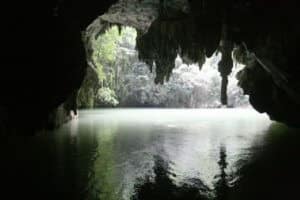
Quiz:
Q1. Which of the following landforms are formed by the erosional action of Glaciers?
- Fjords
- Areti
- Cirque
- V – shape Valley
- Moraines
Select the code from following:
a) 1, 2 and 3 only
b) 2, 3 and 4 only
c) 2, 3 and 5 only
d) All of the above
Solution (a)

It was too easy to understand the concept well than NCERT.